April 2007
Monthly Archive
Monthly Archive
Posted by ben on 30 Apr 2007 | Tagged as: music, performance art, video/film
Around the same time that Destroy All Monsters started playing around with strange music and film footage, The Residents embarked on their underground film project, Vileness Fats. Although the film was never completed, some of the footage was used for music videos in the coming years. From the official Residents web site:
The world of Vileness Fats, consisting of a village, a cave, a desert and a nightclub, is tiny, claustrophobic and primarily populated by one armed midgets…. Two versions of the incomplete feature have been released: the 32 min long “Whatever Happened to Vileness Fats?” (1984) and the tighter 17 1/2 min “Vileness Fats (Concentrate)” (2001), and both come across as artifacts from some hellish but mildly amusing nightmare — the claustrophobic product of a model railroad builder’s beyond bad acid trip.
Here is some of the footage, with part of the classic “Third Reich ‘n Roll” (a commentary on the fascism of the music industry) as the soundtrack:
Also check out the Buñuelesque .
Posted by michelle on 28 Apr 2007 | Tagged as: net.art, poetry, possibilities
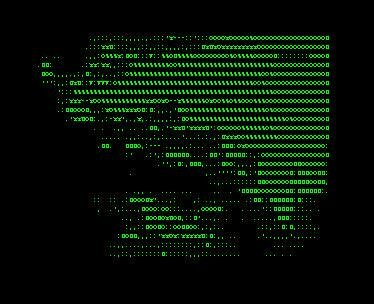
Seems like the Slovanians are onto something, in the case of a guy named Vuk Cosic and the ASCII Art ensemble, you can watch the opening scene of Psycho or perhaps a poignant scene from the brainy landscape of Eisenstein. These online creations remind me of concrete poetry and text as art or occasionally siphoned of meaning as in Magritte’s hypnogogic endeavors. Catalonian poet and Surrealist, Joan Brossa, left a legacy of visual poetry in various forms such as this:
Posted by ben on 27 Apr 2007 | Tagged as: interviews, music
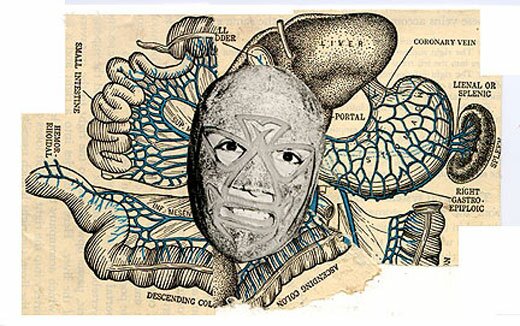
You all know Mark Mothersbaugh for his role in the founding of DEVO, for his work on various soundtracks (including the Pee-wee Herman Show, Rushmore, The Rugrats, and even Revenge of the Nerds II, among others). Although he is less known for his visual art, he has been steadily producing work in this area for decades; in fact, it was while studying art at Kent State that he formed DEVO, partly in response to the Kent State shootings. His work draws on ideas pioneered by the Fluxus movement, with its mixture of whimsy and starkness. Mothersbaugh’s “Postcard Diaries” will be opening at FL!GHT Gallery on May 12, alongside an installation by Sarah Higgins at Salon Mijangos, new work by Kelly Pierce at One9Zero6 Gallery, and music by Hyperbubble and others. He recently agreed to do an email interview with me: Continue Reading »
Posted by michelle on 23 Apr 2007 | Tagged as: responses/reviews
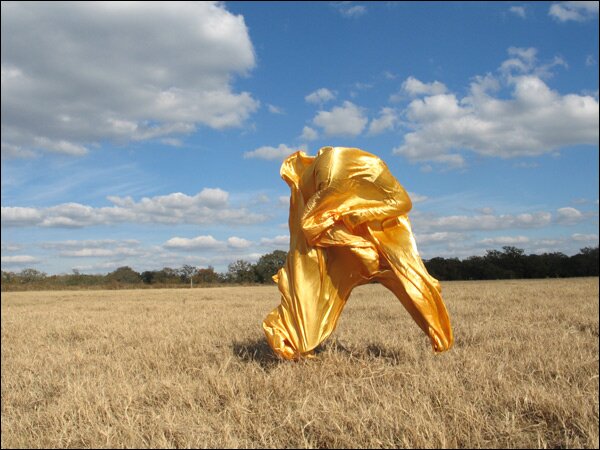
Photographs seem to be capturing my attention lately. I’m compelled to share some of the scintillating gems I uncovered thanks to M + B Gallery in Los Angeles and the thoughtful, informative blog, Conscientious. Austinite William Hundley breaks the monotony of snapshots by poking gravity in the eye in pictures like the image above. He seems to be a favorite over at Wooster Collective. The Lovely Loretta Lux also seems to strike gold with ambiguous, puerile portraits like this:

© 2004 Loretta Lux
Thirty year old Jehad Nga reminds me of Sebastiao Salgado in his ability to uncover the vulnerable humanity behind international headlines.

© 2006 Jehad Nga
For more fun with photography, I softly suggest a visit to the musings of
I Heart Photograph.
Posted by ben on 23 Apr 2007 | Tagged as: music, performance art, video/film
Destroy All Monsters, whose founding members include Mike Kelley and Jim Shaw, was a legendary Detroit anti-rock band with almost no recorded output other than a DVD called , and a now out-of-print 3-CD set released on Ecstatic Peace (a few other live recordings have trickled out and are available here). The group’s shows were an abrasive blend of noise, performance art, and visual chaos. Grow Live Monsters includes no-budget Destroy All Monsters film footage from 1971 to 1976. Around 1976 Kelley and Shaw left the group to pursue their visual art careers, and were replaced by Ron Asheton from the Stooges and MC5 bassist Michael Davis. Here’s a clip from the DVD:
Posted by ben on 21 Apr 2007 | Tagged as: responses/reviews
 I made a second visit to the Museo Alameda today, planning on writing a little review. I hadn’t seen anyone actually review the content of the exhibitions, with most commentary focusing on the political aspects of the enterprise (or worse, fights that broke out at the opening — we’ll let the tabloids cover that topic…). But just now I noticed that Edward Rothstein has already done a pretty good job reviewing the exhibits for the New York Times (this is their second article on the museum). A lot of people I’ve talked to had the same questions: Laura Bush’s purse? Quartz crystals? A satellite? What does this have to do with the Latino experience?
I made a second visit to the Museo Alameda today, planning on writing a little review. I hadn’t seen anyone actually review the content of the exhibitions, with most commentary focusing on the political aspects of the enterprise (or worse, fights that broke out at the opening — we’ll let the tabloids cover that topic…). But just now I noticed that Edward Rothstein has already done a pretty good job reviewing the exhibits for the New York Times (this is their second article on the museum). A lot of people I’ve talked to had the same questions: Laura Bush’s purse? Quartz crystals? A satellite? What does this have to do with the Latino experience?
But I think there is something going on at the museum that could be pretty interesting if executed in a more cohesive way. There is a blend of ancient artifacts, cultural detritus, and contemporary art that is, in my experience, unique. If the curators of the museum were able to make more effective use of the Smithsonian collection (hint: Lady Bird Johnson’s brooch doesn’t help us understand Latino history), but also tie these artifacts to important contemporary work, it could play a role in educating us about the past but also make a positive contribution to the development of Latino culture today. The potential is there, but unfortunately, the first round of exhibits doesn’t quite pull it off.
[Photo: Michael Stravato for The New York Times]
Posted by ben on 20 Apr 2007 | Tagged as: responses/reviews, video/film
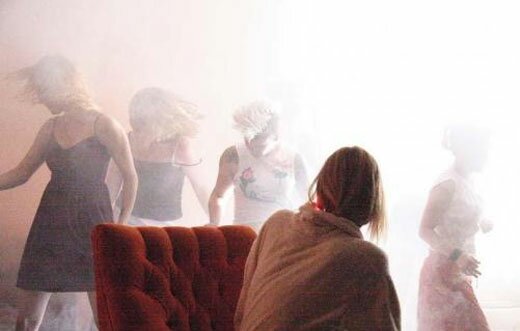
“Inland Empire” last night, not sure a traditional review is the most appropriate response (although that one will give you a good idea of what you’re in for).
But some thoughts. The red velvet curtains, the flickering lights that have haunted Lynch’s work since “Twin Peaks” (or earlier?) return. I think they still work — I think, in fact, they have developed since the Block Lodge. I wonder what this would look like to someone who hadn’t followed Lynch’s work. Are these images strengthened or dulled by a familiarity with Lynch’s vernacular?
To me, it’s not quite as crisp as “Mulholland Drive.” The contrast between acting and living isn’t as striking. There we see a reversal: the superficiality of life contrasted with the reality of acting. Here it all seems to blend and shift, there is rarely a moment in which you can say “ah, she’s acting” or “yes, this is real.” So “Mulholland Drive” remains for me the high point of Lynch’s ability to draw you in emotionally. There are more genuinely funny, scary, passionate moments there than in any of his other work (that I’ve seen).
For some reason, I kept thinking about Buñuel’s “That Obscure Object of Desire,” and how Buñuel used two actresses to play the same character in order to represent the shifts in identity. Lynch, instead, leaves the actress the same, and changes everything around her. Although he did use the Buñuel technique in “Mullholland Drive,” and I think (perhaps) at the very end of “Inland Empire.” If I’m reading this correctly, the shift in roles at the end of “Inland Empire” is a moment of freedom, whereas in “That Obscure Object of Desire” it seems to be a prison.
When the identities of the characters shift, relationships remain intact. I think this is an exploration of the tension between layers of identity. We may reconstruct our identities, but still relive the same relationships, until we transform ourselves on a deeper level. This is the “happy ending,” I think: she fundamentally changes her role in life, somehow.
Ultimately, though, this is a work of texture: visual, auditory, poetic textures contrasting and playing off of each other. Everything from the framing of the shots to the set design, lighting, soundtrack, dialogue and sometimes very subtle shifts in camera focus, give the sense of a development that is simply not narrative. There’s the suggestion of a narrative, of a developing plot, but in many ways it remains a very formal work. It is about the creation of mood, the development of character, the movement of story, but the moods are ambiguous, the characters are unstable, and the plot is pretty much non-existent. As Jason says, this does feel like the culmination of Lynch’s art, and I’ll add, probably about as good a definition of “post-modern” are you are likely to find anywhere.
PS. After the movie, we managed to get to Rock Bottom before Adult. took the stage. Their set, though short, was pretty heavy. They ditched their guitar player, so the synths moved to the forefront, which as Jeff DeCuir predicted at their last show in San Antonio, was a very good thing. I’m not sure if I just didn’t notice before, but their synth work is really interesting, coming from dance / industrial, but moving into abstraction. They can definitely be compared to Throbbing Gristle at times, but with those punkish vocals, the effect is pretty unique.
Posted by ben on 17 Apr 2007 | Tagged as: upcoming events, video/film
David Lynch’s new movie, Inland Empire, is playing at the Bijou through Thursday night. If you haven’t seen it yet, catch it while you can!
Posted by ben on 17 Apr 2007 | Tagged as: responses/reviews
The other night I had a dream that I was searching for one of Sol LeWitt’s cubes in an ancient temple turned into a modern tourist attraction. I won’t go into detail, but the whole dream embodied this strange tension between spirituality, diversion, and aesthetics; not to mention antiquity and modernity.
The morning after this dream, I came across an article in the New York Times about Gregor Schneider’s black cube sculpture in Hamburg. This piece is intended to resemble the Kaaba, a huge cube at the center of the Great Mosque in Mecca. Although there is no law in Islam against representing the Kaaba (and it has been represented many times), the piece has been considered too politically charged to show by several institutions. It is now finally being shown outside the Hamburger Kunsthalle as part of an exhibit honoring Malevich.
There are too many convergences here for me to follow all the threads, but the transformation of the cube from spirit (Kaaba, and also New Jerusalem), to feeling (Malevich), to concept (LeWitt), to politics (Gregor) is really leaving me speechless right now.
Posted by justin on 17 Apr 2007 | Tagged as: possibilities, silliness
Posted by justin on 16 Apr 2007 | Tagged as: art paparazzi, in yo face, party photos, silliness
The Museo Alameda Smithsonian Affiliated museum of Latin American Art opened its doors to the (ritzy) public this past Thursday, with a $250 dollar a head gala. Heres a few highlights from the opening. go Here for the entire story.

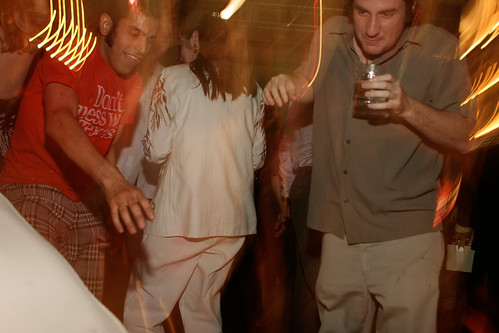

(the king of party, Karlos with a K)

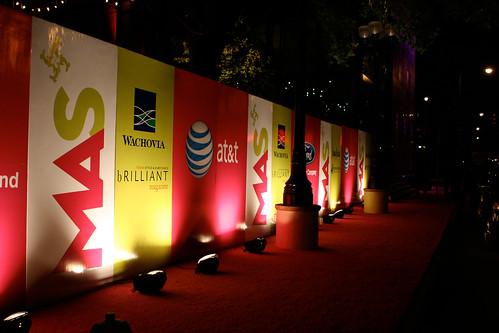

(this is what happens when you over-photograph david zamoras casas)

(yes, thats our own Ben “Jammin” Judson right there)
It sure was fun. Check out my Flickr page for more.
Posted by ben on 16 Apr 2007 | Tagged as: music, sound art, video/film
I just discovered Piotr Kamler while searching YouTube for work by Bernard Parmegiani (Parmegiani scored some of Kamler’s films). Kamler’s films are a kind of lyrical, abstract take on science fiction, with stunning animation sequences executed in a wide variety of media.
Here’s Une Mission Ephemere (1993; scored by Parmegiani):
Also check out (scored by Francois Bayle). Here’s a good discussion of the work of Kamler and his contemporaries. And if you like the soundtrack: two Parmegiani albums are available for download on Mutant Sounds right now.
Posted by michelle on 15 Apr 2007 | Tagged as: performance art
Nothing lost in translation, thanks to the Oldenburg props.